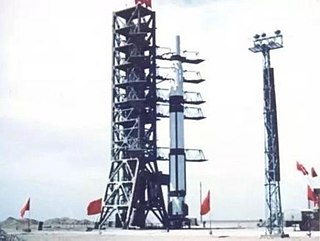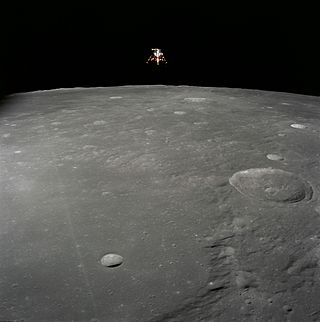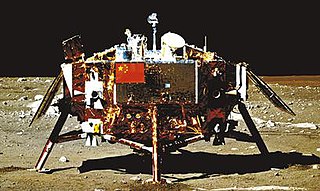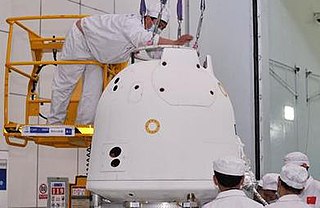See also
- Chang (disambiguation)
- Chang-Ngo – a crater on the Moon
- Chinggis (disambiguation)
- Chang'e, a hero in Mobile Legends: Bang Bang
Chang'e is a Chinese moon goddess.
Chang'e may also refer to:

A lander is a spacecraft that descends towards, then comes to rest on the surface of an astronomical body other than Earth. In contrast to an impact probe, which makes a hard landing that damages or destroys the probe upon reaching the surface, a lander makes a soft landing after which the probe remains functional.

The space program of the People's Republic of China is about the activities in outer space conducted and directed by the People's Republic of China. The roots of the Chinese space program trace back to the 1950s, when, with the help of the newly allied Soviet Union, China began development of its first ballistic missile and rocket programs in response to the perceived American threats. Driven by the successes of Soviet Sputnik 1 and American Explorer 1 satellite launches in 1957 and 1958 respectively, China would launch its first satellite, Dong Fang Hong 1 in April 1970 aboard a Long March 1 rocket, making it the fifth nation to place a satellite in orbit.

The far side of the Moon is the lunar hemisphere that always faces away from Earth, opposite to the near side, because of synchronous rotation in the Moon's orbit. Compared to the near side, the far side's terrain is rugged, with a multitude of impact craters and relatively few flat and dark lunar maria ("seas"), giving it an appearance closer to other barren places in the Solar System such as Mercury and Callisto. It has one of the largest craters in the Solar System, the South Pole–Aitken basin. The hemisphere has sometimes been called the "dark side of the Moon", where "dark" means "unknown" instead of "lacking sunlight" – each location on the Moon experiences two weeks of sunlight while the opposite location experiences night.

A Moon landing or lunar landing is the arrival of a spacecraft on the surface of the Moon, including both crewed and robotic missions. The first human-made object to touch the Moon was Luna 2 in 1959.

A lunar lander or Moon lander is a spacecraft designed to land on the surface of the Moon. As of 2024, the Apollo Lunar Module is the only lunar lander to have ever been used in human spaceflight, completing six lunar landings from 1969 to 1972 during the United States' Apollo Program. Several robotic landers have reached the surface, and some have returned samples to Earth.

The physical exploration of the Moon began when Luna 2, a space probe launched by the Soviet Union, made a deliberate impact on the surface of the Moon on September 14, 1959. Prior to that the only available means of exploration had been observation from Earth. The invention of the optical telescope brought about the first leap in the quality of lunar observations. Galileo Galilei is generally credited as the first person to use a telescope for astronomical purposes; having made his own telescope in 1609, the mountains and craters on the lunar surface were among his first observations using it.

The Chinese Lunar Exploration Program, also known as the Chang'e Project after the Chinese Moon goddess Chang'e, is an ongoing series of robotic Moon missions by the China National Space Administration (CNSA).

A rover is a planetary surface exploration device designed to move over the rough surface of a planet or other planetary mass celestial bodies. Some rovers have been designed as land vehicles to transport members of a human spaceflight crew; others have been partially or fully autonomous robots. Rovers are typically created to land on another planet via a lander-style spacecraft, tasked to collect information about the terrain, and to take crust samples such as dust, soil, rocks, and even liquids. They are essential tools in space exploration.

Chang'e 2 is a Chinese uncrewed lunar probe that was launched on 1 October 2010. It was a follow-up to the Chang'e 1 lunar probe, which was launched in 2007. Chang'e 2 was part of the first phase of the Chinese Lunar Exploration Program, and conducted research from a 100-km-high lunar orbit in preparation for the December 2013 soft landing by the Chang'e 3 lander and rover. Chang'e 2 was similar in design to Chang'e 1, although it featured some technical improvements, including a more advanced onboard camera. Like its predecessor, the probe was named after Chang'e, an ancient Chinese moon goddess.

Chang'e 3 is a robotic lunar exploration mission operated by the China National Space Administration (CNSA), incorporating a robotic lander and China's first lunar rover. It was launched in December 2013 as part of the second phase of the Chinese Lunar Exploration Program. The mission's chief commander was Ma Xingrui.

A lunar rover or Moon rover is a space exploration vehicle designed to move across the surface of the Moon. The Apollo program's Lunar Roving Vehicle was driven on the Moon by members of three American crews, Apollo 15, 16, and 17. Other rovers have been partially or fully autonomous robots, such as the Soviet Union's Lunokhods, Chinese Yutus, Indian Pragyan, and Japan's LEVs. Five countries have had operating rovers on the Moon: the Soviet Union, the United States, China, India, and Japan.

Chang'e 4 is a robotic spacecraft mission in the Chinese Lunar Exploration Program of the CNSA. China achieved humanity's first soft landing on the far side of the Moon with its touchdown on 3 January 2019.

Chang'e 5 was the fifth lunar exploration mission in the Chinese Lunar Exploration Program of CNSA, and China's first lunar sample-return mission. Like its predecessors, the spacecraft is named after the Chinese moon goddess, Chang'e. It launched at 20:30 UTC on 23 November 2020, from Wenchang Spacecraft Launch Site on Hainan Island, landed on the Moon on 1 December 2020, collected ~1,731 g (61.1 oz) of lunar samples, and returned to the Earth at 17:59 UTC on 16 December 2020.

Yutu was a robotic lunar rover that formed part of the Chinese Chang'e 3 mission to the Moon. It was launched at 17:30 UTC on 1 December 2013, and reached the Moon's surface on 14 December 2013. The mission marks the first soft landing on the Moon since 1976 and the first rover to operate there since the Soviet Lunokhod 2 ceased operations on 11 May 1973.

Chang'e 5-T1 was an experimental robotic spacecraft that was launched to the Moon on 23 October 2014, by the China National Space Administration (CNSA) to conduct atmospheric re-entry tests on the capsule design planned to be used in the Chang'e 5 mission. As part of the Chinese Lunar Exploration Program, Chang'e 5, launched in 2020, was a Moon sample return mission. Like its predecessors, the spacecraft is named after the Chinese Moon goddess Chang'e. The craft consisted of a return vehicle capsule and a service module orbiter.

Chang'e 6 is a robotic lunar exploration mission by the China National Space Administration. As China's second sample return mission, it will attempt to obtain a sample of soil and rock from the far side of the Moon, while conducting scientific experiments on the lunar surface. Like its predecessors in the Chinese Lunar Exploration Program, the spacecraft is named after the Chinese Moon goddess Chang'e. It was launched on 3 May 2024 and the mission is expected to last about 53 days. The mission's lander landed on the lunar far side on 1 June 2024.

The year 2024 is expected to exceed 2023's 223 orbital launches. So far, the year saw the successful first launch of Vulcan Centaur, Gravity-1, and notably the third developmental launch of SpaceX's Starship – IFT-3, with IFT-4, IFT-5, and IFT-6 planned for this year. Additionally, the final launch of a Delta family rocket occurred in April with a Delta IV Heavy. In May, China launched the Chang'e 6, the first sample return from the far side of the Moon. By 13 May, there were 92 total launch attempts, equaling the total number of attempts for the whole year in 2014, just 10 years prior. Following the trend of the 2020s, it is expected that many more privately-developed launch vehicles will feature a maiden launch in 2024.

The International Lunar Research Station (ILRS) (Chinese: 国际月球科研站) is a planned lunar base currently being led by Roscosmos and the China National Space Administration (CNSA). The ILRS will serve as a comprehensive scientific experiment base built on the lunar surface or in lunar orbit that can carry out multi-disciplinary and multi-objective scientific research activities including exploration and utilization, lunar-based observation, basic scientific experiment and technical verification, and long-term autonomous operation. Statements from Roscosmos and CNSA underline that the project will be "open to all interested countries and international partners."